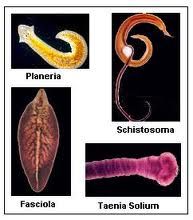Phylum Platyhelminthes
Flatworms and tapeworms are popular names for Platyhelminthes. They are a type of invertebrate with a soft body. In reality, there are over 20,000 different species of these animals. A few of these parasites live on humans and other animals as parasites. Furthermore, because of their parasitic nature, they do cause some discomfort to the host animal. Schistosomiasis, often known asbilharziasis, is a parasitic flatworm disease. A few species in this phylum are known to be major causes of disease. They are triploblastic, acoelomate, and bilaterally symmetrical. Their body is dorsoventrally flattened which is its most noticeable feature. They are flat because the body has no cavities. They also lack specialized systems and do not have segmented bodies. They have no specialized circulatory and respiratory organs, which allows oxygen and nutrients to pass through their bodies by diffusion.Around 80% of the flatworms are parasitic, with a few free-form flatworms thrown in for good measure. Scavengers or predators are the free-living forms. The parasitic species feed on the tissues of the organism they dwell in. Planaria, for example, has a high potential for regeneration. This phylum's animals come in a wide range of sizes. Some are minuscule, while others can reach lengths of up to two feet. They're also hermaphrodites, which means they have both sexes living in the same body.They typically reproduce both sexually and asexually. For instance, Taenia (Tapeworm) and Fasciola (Liver fluke).


 ACME SMART PUBLICATION
ACME SMART PUBLICATION
